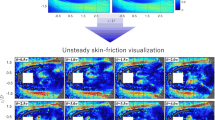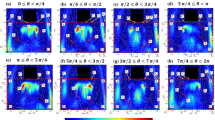Abstract
In this study, the optical flow method for the skin-friction-stress estimation from the unsteady oil film distribution was reformulated based on the variational method, and the validity of the proposed method was verified in comparison with the conventional method. The regularization is proposed to be added directly to the skin-friction-stress field in the proposed method while the regularization is added to the amount of oil movement in the conventional method. As a result, the smoothness of the skin-friction-stress field can be controlled by adjusting the regularization parameter in the proposed method whereas it was difficult in the conventional method. The performance of the proposed method was evaluated to be superior to the previous method through the numerical and experimental data.
Graphic Abstract















Similar content being viewed by others
References
Bottini H, Kurita M, Iijima H, Fukagata K (2015) Effects of wall temperature on skin-friction measurements by oil-film interferometry. Measur Sci Technol. https://doi.org/10.1088/0957-0233/26/10/105301
Brown JL, Naughton JW (1999) The thin oil film equation. Tech Rep NASA/TM-1999-208767, NASA, Washington, DC
Chen L, Suzuki T, Nonomura T, Asai K (2019) Characterization of luminescent mini-tufts in quantitative flow visualization experiments: Surface flow analysis and modelization. Exp Ther Fluid Sci 103:406–417. https://doi.org/10.1016/j.expthermflusci.2019.02.002
Chen L, Suzuki T, Nonomura T, Asai K (2020) Flow visualization and transient behavior analysis of luminescent mini-tufts after a backward-facing step. Flow Measur Instr 71:101657
Costantini M, Lee T, Nonomura T, Asai K, Klein C (2021) Feasibility of skin-friction field measurements in a transonic wind tunnel using a global luminescent oil film. Exp Fluids 62(1):1–34
Depardon S, Lasserre JJ, Boueilh JC, Brizzi LE, Borée J (2005) Skin friction pattern analysis using near-wall PIV. Exp Fluids 39(5):805–818. https://doi.org/10.1007/s00348-005-0014-8
Driver DM, Drake A (2008) Skin friction measurements using oil-film interferometry in nasa’s 11-foot transonic wind tunnel. AIAA J 46(10):2401–2407
Fonov S, Jones G, Crafton J, Fonov V, Goss L (2006) The development of optical techniques for the measurement of pressure and skin friction. Measur Sci Technol 17(6):1261. https://doi.org/10.1088/0957-0233/17/6/s05
Horn BK, Schunck BG (1981) Determining optical flow. Artif Intell 17(1–3):185–203
Iijima H, Uchiyama T, Kato H (2021) Temperature correction for oil film interferometry with infrared camera in skin friction measurements. J Visual pp 1–8
Kim S, Patel V (1991) Laminar flow separation on a spheroid at incidence. In: 22nd fluid dynamics, plasma dynamics and lasers conference, p 1803
Kuwata M, Abe Y, Yokota S, Nonomura T, Sawada H, Yakeno A, Asai K, Obayashi S (2021) Flow characteristics around extremely low fineness-ratio circular cylinders. Phys Rev Fluids 6(5):054704
Lee C, Lee T, Nonomura T, Asai K (2020) Evaluating the applicability of a phase-averaged processing of skin-friction field measurement using an optical flow method. J Visual 23(5):773–782
Lee T (2017) A least-squares-based optical-flow method for skin-friction field measurement using luminescent oil film. M.S. thesis, Tohoku University, Sendai, JAPAN
Lee T, Nonomura T, Asai K, Liu T (2018) Linear least-squares method for global luminescent oil film skin friction field analysis. Rev Sci Instr 89(6):065106
Lee T, Nonomura T, Asai K, Naughton JW (2019) Validation and uncertainty analysis of global luminescent oil-film skin-friction field measurement. Measur Sci Technol
Lee T, Lee C, Nonomura T, Asai K (2020) Unsteady skin-friction field estimation based on global luminescent oil-film image analysis. J Visual 23(5):763–772
Liu T, Shen L (2008) Fluid flow and optical flow. J Fluid Mech 614:253–291
Liu T, Montefort J, Woodiga S, Merati P, Shen L (2008) Global luminescent oil-film skin-friction meter. AIAA J 46(2):476–485
Liu T, Woodiga S, Montefort J, Conn K, Shen L (2008) Mapping skin friction fields in complex flows using luminescent oil. In: 46th AIAA aerospace sciences meeting and exhibit, p 267
Meloy J, Griffin J, Cattafesta L, Sells J, Sheplak M, Chandrasekharan V (2011) Experimental verification of a mems based skin friction sensor for quantitative wall shear stress measurement. In: 41st AIAA fluid dynamics conference and exhibit, p 3995, 10.2514/6.2011-3995
Naughton JW, Sheplak M (2002) Modern developments in shear-stress measurement. Prog Aerosp Sci 38(6–7):515–570
Patel V (1965) Calibration of the preston tube and limitations on its use in pressure gradients. J Fluid Mech 23(1):185–208
Plesniak M, Peterson S (2004) Wall shear stress measurements for conventional applications and biomedical flows. In: 24th AIAA aerodynamic measurement technology and ground testing conference, p 2301
Reda DC, Wilder MC, Farina DJ, Zilliac G (1997) New methodology for the measurement of surface shear stress vector distributions. AIAA J 35(4):608–614. https://doi.org/10.2514/2.165
Van Leer B (1979) Towards the ultimate conservative difference scheme. v. a second-order sequel to godunov’s method. J Comput Phys 32(1):101–136
Yokota S, Ochiai T, Ozawa Y, Nonomura T, Asai K (2021) Analysis of unsteady flow around an axial circular cylinder of critical geometry using combined synchronous measurement in magnetic suspension and balance system. Exp Fluids 62(1):1–20
Zilliac G, Pulliam T, Rivers M, Zerr J, Delgado M, Halcomb N, Lee H (2011) A comparison of the measured and computed skin friction distribution on the common research model. In: 49th AIAA aerospace sciences meeting including the new horizons forum and aerospace exposition, p 1129
Acknowledgements
This work was partially supported by JSPS KAKENHI Grant Number 20H00278 and 19KK0361, and JST FOREST Grant Number JPMJFR202C.
Author information
Authors and Affiliations
Corresponding author
Additional information
Publisher's Note
Springer Nature remains neutral with regard to jurisdictional claims in published maps and institutional affiliations.
Rights and permissions
About this article
Cite this article
Endo, K., Ambo, T., Saito, Y. et al. Proposal and verification of optical flow reformulation based on variational method for skin-friction-stress field estimation from unsteady oil film distribution. J Vis 25, 263–280 (2022). https://doi.org/10.1007/s12650-021-00794-8
Received:
Revised:
Accepted:
Published:
Issue Date:
DOI: https://doi.org/10.1007/s12650-021-00794-8




